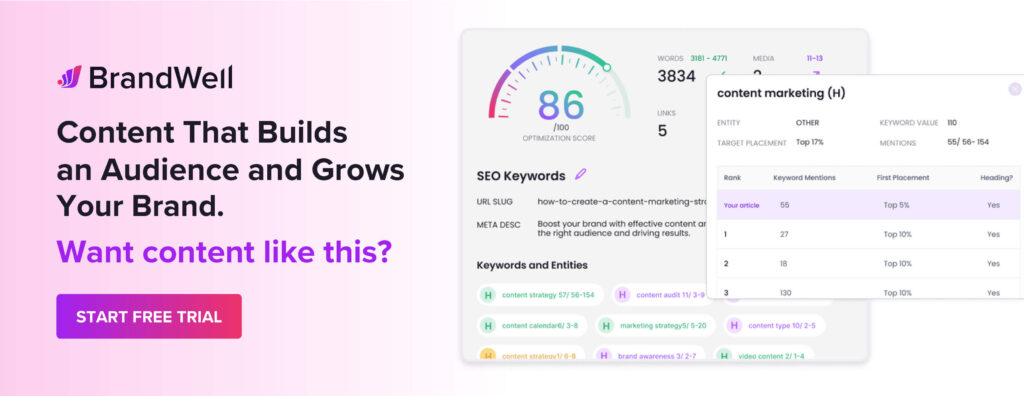Discover top guides, trends, tips and expertise from AIO Writers
How to Build Trust in Blogs: 11 Tips for Impeccable AI Content
Julia McCoy
Monday, 13th Mar 2023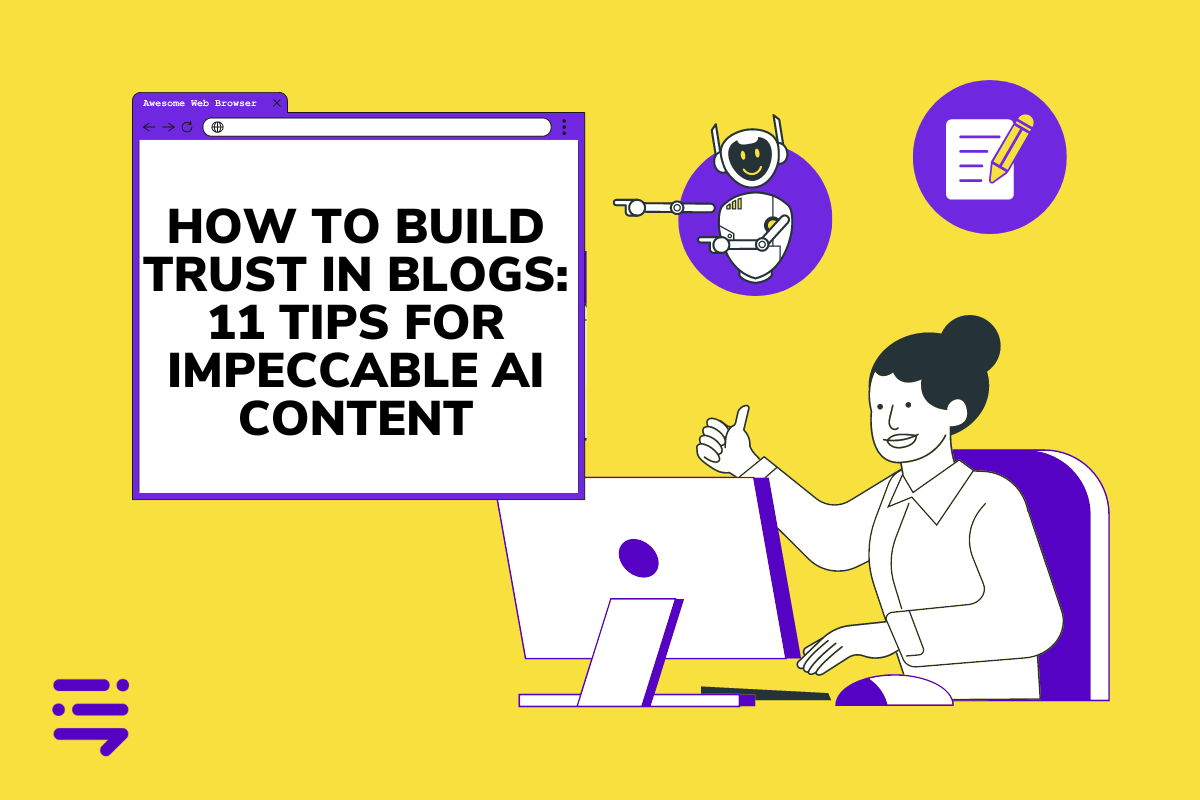
Good content conveys information, but great content builds trust. AI-generated content easily passes the first test, but it struggles with the latter. It does not always come out as totally trustable out of the gate.
Here’s the thing, though. While you should guard against spreading false information, as a blog writer you’re not held to the same standards as a newspaper, for example, in terms of your trustworthiness as an information source. But your writing absolutely has to be trustable.
This article will teach you how to build trust with your AI-generated blog articles.
Read on to discover how to turn a mechanical-sounding AI-generated draft into impeccable content that reels readers in and grips their attention to the end.
Table of Contents
Why is It Important to Build Trust with Your Blog Writing?
People only buy from people they trust. Similarly, readers take and act on advice and counsel from writers whose writing they trust. When they trust your content, they are also likely to recommend and share it.
So, if you can’t get the reader to trust your information, your content will not accomplish its intended goals.
The challenge you have as a writer/marketer is that your human readers have trust issues where AI content is concerned. I say human readers because Google may like your AI content enough to rank it.
Yes, AI content can rank. The challenge is after it ranks, people still have to read it and be informed by it enough to take the actions you want them to. Those actions require a fair bit of trust on the part of the reader.
An informed reader knows what they want, which means they read your content and go away to solve their problem. You have a problem, however, if they use your information to learn what solution they need but then opt for your competitor’s product as their solution.
If you had earned their trust, they would take a chance on your solution. They would consider your solution simply because you have earned it, not because your product is the best. As consumers, we don’t always select products to maximize utility. We choose brands that make the best impression on us.
How to Build Trust With AI-Generated Blog Posts
AI content tends to be disconnected and impersonal. It lacks that personal touch and relatability that makes content written by one who has been there and lived to talk about it so good.
Even though it is machine-generated, AI content can be engineered to address reader pain points and optimized to build trust and make a genuine connection with readers.
The engineering part is you telling the AI exactly what to write about.
The second part of building trust and establishing a connection with readers is you again optimizing the draft the AI turns out for human readers.
Here’s how you build trust with AI content and make it impeccably better:
1. Write to One Specific Reader
Content that targets everybody impresses no specific reader. No one finds that content trustable because it does not speak to them. That one reader is a representation of your target reader, not one specific individual.
Let’s take it right from the start of the process of generating an article with an AI writer. I am assuming you have a target keyword in mind. You want your article to target people making specific searches in Google.
That’s a good start, but you’ve got to go deeper:
- Who are the people behind these searches?
- What industry do they work in?
- What problem do they want to fix?
- What are their hopes and fears?
- What knowledge gaps do they have about your topic?
The article the AI generates will perform a lot better both on search engines and with readers if it focuses on a specific reader. A reader whose feelings, thoughts, professional struggles, and ambitions you truly understand.
For us at BrandWell, a challenge that we get out of bed to solve every day is ‘how to scale content creation’. The high cost and time investment it takes to scale content creation is the business problem our product is designed to solve.
Importantly, we know who is facing this challenge – affiliate marketers, business owners, and agency owners who want to scale content creation at a manageable cost. This is the reader we write for when we blog.
2. Put Yourself in the Reader’s Shoes
In the same way, marketers design their offers with their buyer personas in mind, you must identify your ideal reader so that the AI knows who it’s writing for. In essence, you want to put the AI in the reader’s shoes.
Ask yourself what questions your reader would ask that are related to your main topic or target keyword. These are the questions you want the AI to answer. But where do you find these questions?
Google your target keyword and check the SERP for the ‘People Also Ask’ carousel. Some of the questions Google pulls up for the PAA carousel are what your readers are asking. Answer these questions directly in your article and you will not have to work as hard to earn their trust.
3. Use an Outline
An outline focuses your thoughts and guides your writing. It does the same for an AI writer. Using one is even more important for long-form articles for which staying on topic can be a challenge. A well-outlined article follows a logical structure, which shows the reader you are committed to solving their problem.
Thankfully, with BrandWell, you don’t have to manually create an outline. The AI automatically generates one for you. We call it a brief. You can even edit and customize the outline by adding more subheaders if it misses some important points.
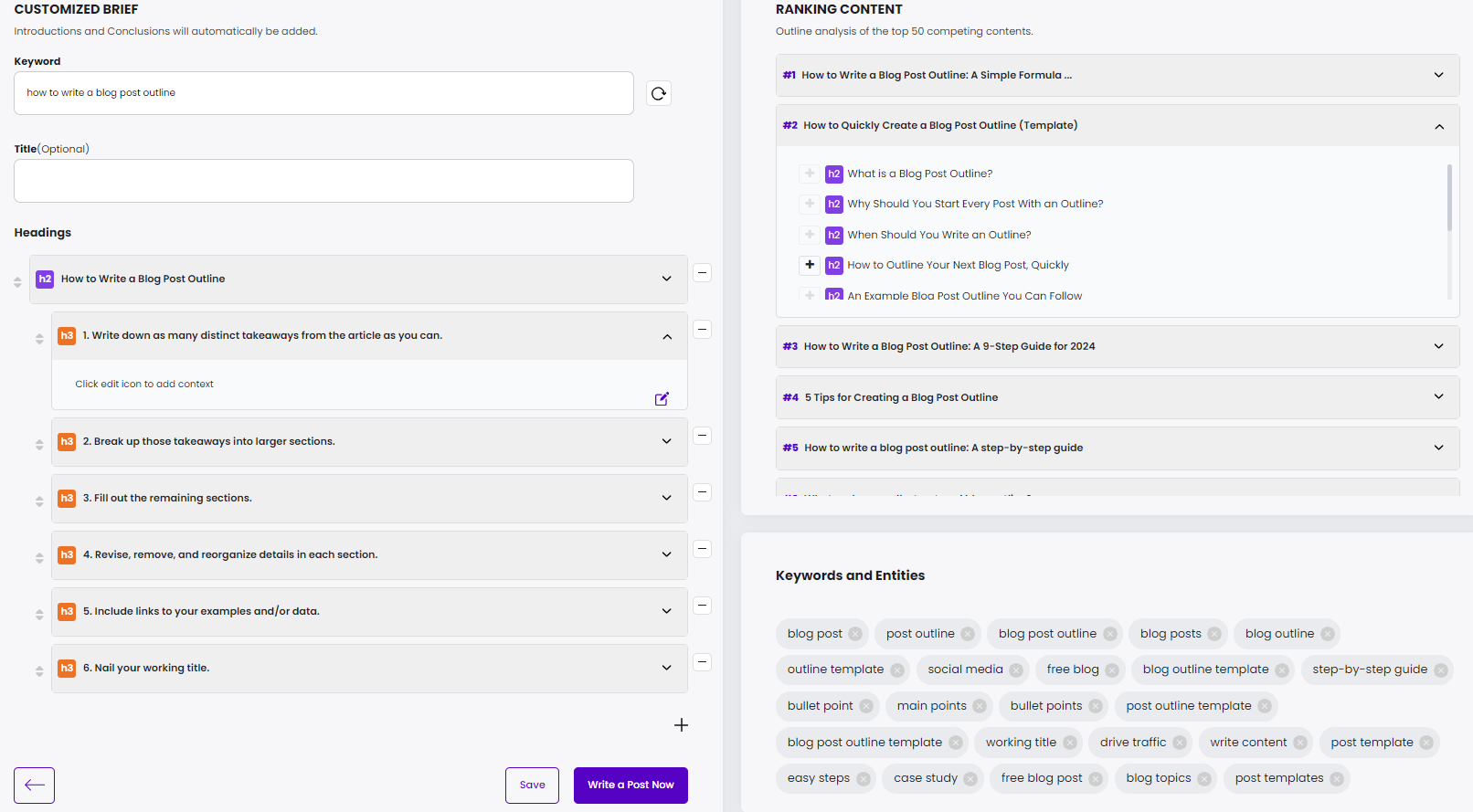
Your article will be ready a few minutes after you hit the Write a Post Now button.
4. Make a Promise You Can Deliver On
Most of your readers will be organic traffic from Google. If you rank number 1 for your target keyword you have the advantage of being the page Google trusts to recommend to its users.
But the SERP has other pages your reader could also choose to click on and read, especially if the titles for those pages are more enticing. So to get the click, you use persuasive language to write your SEO title.
Be careful, though, to not promise with your headline what your article cannot deliver. Review the title the AI generates to make sure it actually promises something. People don’t click unless the title promises them something tangible.
The title is one part of your article you want to take your time with. But while you want the article’s meta title to promise something that’s enticing enough to get the click, you should only promise what the article can deliver. Don’t be vague, either.
Of course, you should include the target keyword in the title as that also encourages clicks. Your title will also attract more clicks if:
- It has a number.
- Includes a power word.
- Is specific and written for the user.
If after scanning the article the reader finds out they have been duped, you’re losing their trust, FAST.
This article you’re reading promises 11 tips on how to build trust in AI content and that’s what you get. You knew what you were getting when you clicked because it clearly shows that it is a how-to guide.
5. Talk to the Reader Directly
As a writer, you are technically broadcasting a message because the reader can’t talk back in real time. It’s a monologue, but that does not mean you cannot make it sound like a dialogue.
Imagine yourself casually talking to the reader over a cup of tea. In their place, put your friend. As you go through the AI-generated draft, look for instances where the AI talks in the third person and does not address the reader directly.
You don’t want to talk about yourself too much, but the reader must know you are offering yourself as the teacher, advisor, or solution provider. At the same time, make it clear you are in conversation with the reader. Use ‘you’ and ‘your’ more than you use ‘they’ and ‘their’. Use ‘I’ and ‘we’ to sound more supportive and hopeful.
“Good writing is good conversation, only more so.”
― Ernest Hemingway
Your content makes a stronger impact when you write conversationally. One way of doing that is to ask questions, even rhetorical ones. Other tips to write more conversationally include using active voice, using contractions, using simple words, and writing short sentences.
BrandWell allows you to customize the tone of voice you want it to use when writing your blog posts. On your Project Settings, click Tone of Voice to choose from default options such as academic, bold, casual, dramatic, excited, grumpy, persuasive, sarcastic, or witty.
Or you can train the AI to “learn” your writing style by feeding it up to three examples of your previous work.
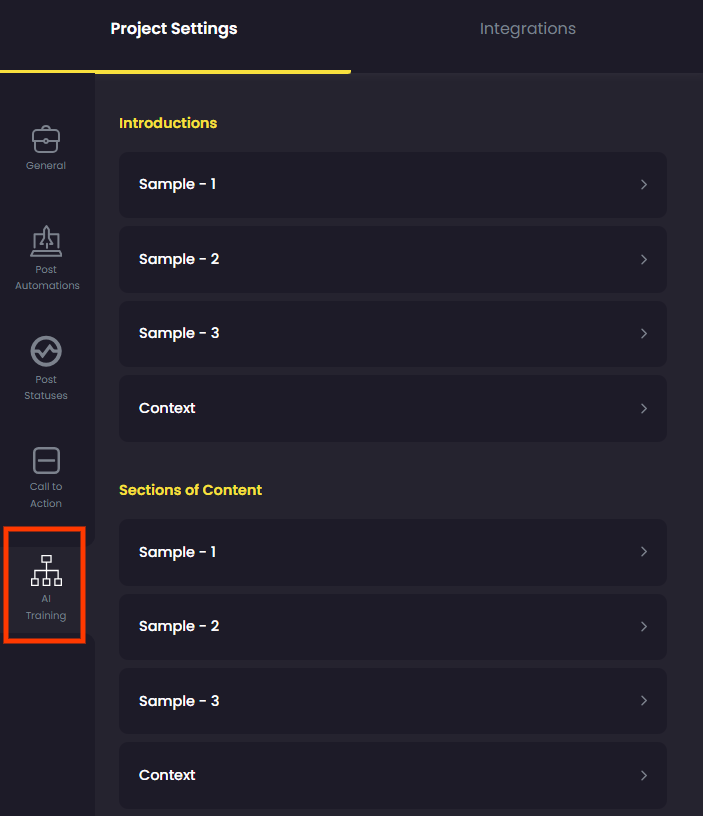
6. Use Plain, Accessible Language
The reader is not interested in how smart you are or how strong your vocabulary is. All they want is for you to solve their problem, and they will freely open themselves up if you make your information digestible.
One way you can make it easy for readers to access your help is by using language that they understand. Avoid overly formal language as it can come off as pretentious. If you communicate information in a clear manner, your message will get to more people.
Avoid all jargon, even if it means you fail to get your point across as accurately as you would like. Substitute technical language for universal, everyday language. Where possible, borrow the language of your audience.
If you find yourself pulling up the Power Thesaurus, let it be because you are looking for a simpler word than the one you have in mind. Those simpler words prevent potential misunderstanding of your message due to language and literacy barriers.
7. Use Personal Stories to Humanize the Draft
When people read your AI content, you want them to feel like they are talking to a person, not a machine. One way of doing this is by weaving personal stories into the article.
You will have to manually add your personal stories to the draft because the AI can’t cite personal stories. Your lived experiences are the one thing that you have that the AI does not. Make use of any personal stories that fit the article to humanize it and make the content more relatable.
AI writers use pre-existing information to create content. So while the content is well-researched, it is not as unique. Blending in personal stories helps add uniqueness and dumbs down traces of AI, making your draft read more original.
If you are writing for a brand, your personal stories may not be appropriate or relevant. But even your brand has stories behind it. Stories like how hard it was to get proof of concept and those first few customers that launched you as a business. Use those stories to humanize your AI drafts.
8. Show Empathy, Not Sympathy
Readers go to Google to find solutions to their problems, not sympathy. They do not want you to feel sorry for them. What they will appreciate from you is empathy – showing them that you understand their thoughts and feelings.
Your ability to show empathy goes back to the point we made earlier about putting the AI in the reader’s shoes. Empathy shows the reader that you really get them, which establishes a strong connection between you and them.
Don’t be afraid to infuse some emotion into the content. It shows there is a human being with feelings on the other side of the screen. Open yourself up a little, share the odd joke, and write as you would talk to a friend you care about. Yes, you should be professional, but be authentic too.
9. Don’t Generalize, Stick to Facts
Generic language is what marks wishy-washy blogs from impactful articles that reel the reader in and hold their attention for the whole piece. Content that does not contextualize and use facts insults the reader by suggesting that they don’t know what they are after.
You get the reader’s trust when you help them solve their problem. Use facts and examples to back up your points and make your advice more actionable. You can use personal examples and even fictitious ones if it helps you get your point across.
The problem with AI is that it does not know what it does not know. It will always write something, even if it’s not factual.
Your task is to identify areas where the AI wrote something that can’t be substantiated and where it didn’t share any critical information. Sometimes the AI will repeat something it has already said, phrased differently. That is fluff that you should chop.
In place of the repetitions and generalized points, put facts, statistics, and quotes from experts in your space. You will have to research these. Even better, highlight your facts with bold letters and links to the original sources. Use block quotes to highlight your quotes.
Using quotes and statistics in your writing shows you’re widely read and have researched thoroughly. Linking to credible external resources shows that your content really is about the reader. When you link out your internal links also don’t come across as overly promotional.
The good news is, BrandWell now does external linking automatically. You will notice that your AI draft now contains links to credible sources where the AI makes claims. This is one feature that no AI writer can offer.
10. Don’t Tell, Show
People and brands that talk about themselves too much are not very likable. When you do that it is easy to beat your chest and tout your achievements, which can come off as showing off.
So take the focus away from yourself and put it where it should be – on the reader. More specifically, quickly get on with the business of solving the reader’s problem.
The quickest way to share your solution is to show it. Of course, you can explain it, but that can take too long. And the reader may not understand it. One way of showing instead of telling is by using visuals like this:
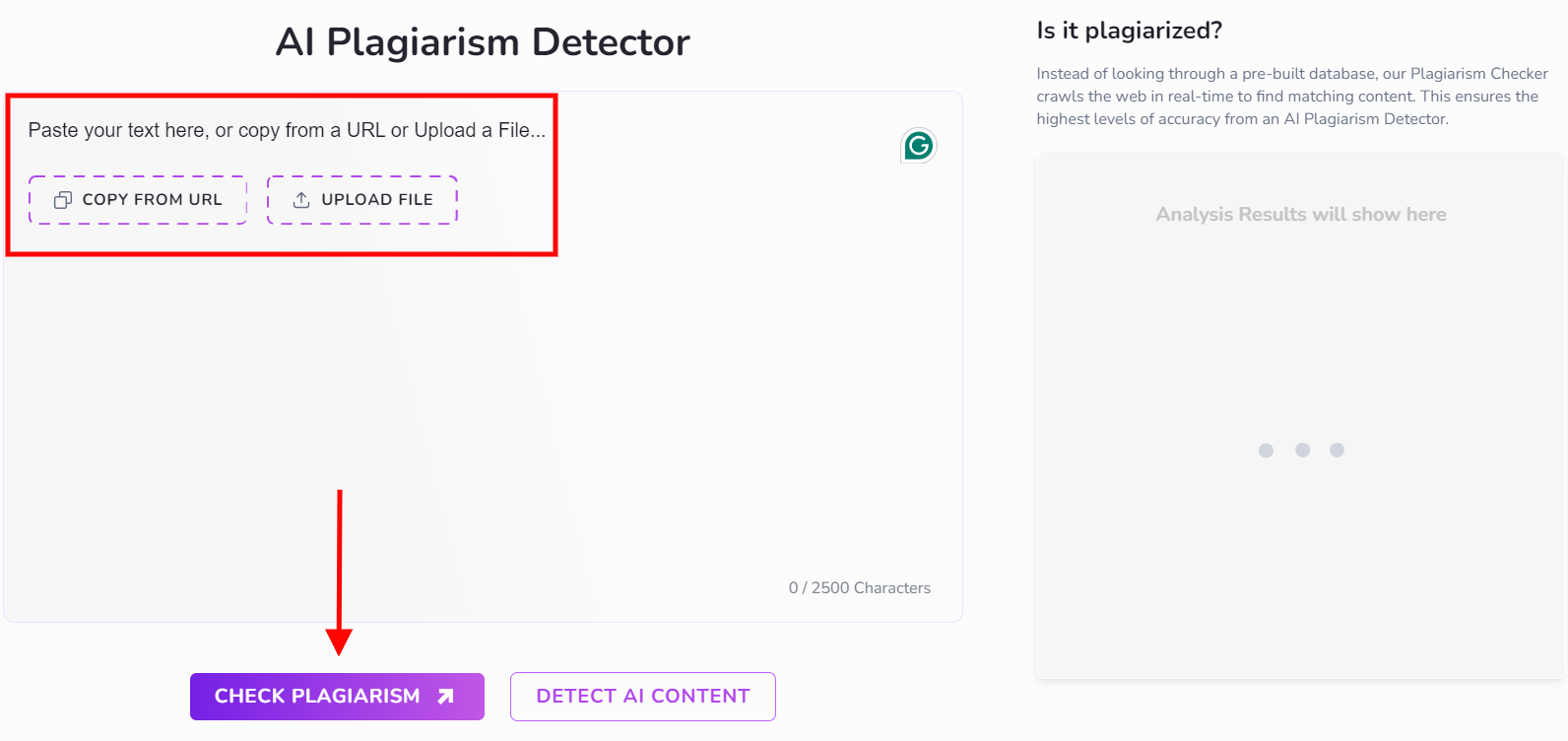
In this post, you have already seen how we do that with screenshots of our content marketing platform. Most of these screenshots have arrows, highlights, and annotations to make it easier to know how to do specific things with the software.
11. Proofread
Poor grammar, typos, and misspellings reflect badly on the writer. It shows you as sloppy. It begs the question, if you are sloppy with grammar, can you be trusted with facts?
While the AI writes well, its content can sound robotic and it does occasionally miss minor details. Proofreading allows you to pick up and fix these issues.
“The ear, not the eye, is the final editor.”
Donald M. Murray, Pulitzer Prize-winning journalist.
Another helpful trick is to read the draft aloud. It particularly helps to identify unnatural language that a proofreading app might miss.
Key Takeaway: To effectively build trust when writing blog posts, it’s important to understand your target audience, research relevant keywords, and create content that is valuable and solves problems. Writing in the language your readers understand also helps to simplify your AI content and make it more accessible.
How to Punch Up Blog Conclusions and CTAs
Truth: If you can’t build trust with your readers, you’ve failed at content marketing.
One way to get closer to building trust is by improving your blog conclusions and calls-to-action (CTAs).
By using actionable language tips such as adding transition sentences, using “you” language, and embracing informal sentence starters like “and,” you can increase reader engagement.
Use Transition Sentences for Better Flow
To create smooth transitions between paragraphs or sections within a conclusion, use transitional phrases that help guide readers from one idea to another. Some examples include:
- In addition,
- Furthermore,
- Moreover,
- Last but not least,
- And,
- But,
The inclusion of “and” and “but” isn’t a mistake, by the way. Though your English teachers probably lectured you NOT to start sentences with these words, that’s a mistake for your online content.
Why?
These are super simple conjunctions that have the power to tie two ideas or thoughts together. Using them strategically will help you create a flow in your content that effortlessly pulls readers down the page.
Overall, transition words can link together consecutive paragraphs that would otherwise read like bullet points in a list. Here’s an example of a conclusion paragraph with no transitions:
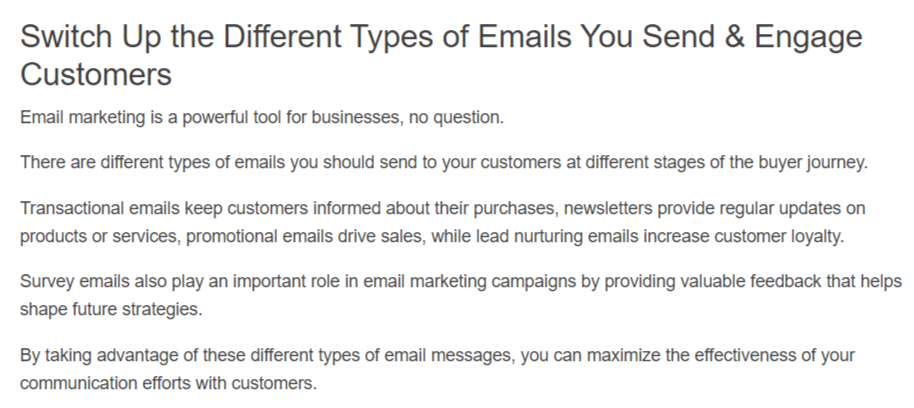
Conclusion paragraph without transitions.
See how paragraphs 2-4 read like a bulleted list? Let’s look at the difference we can make in readability by adding transitions.
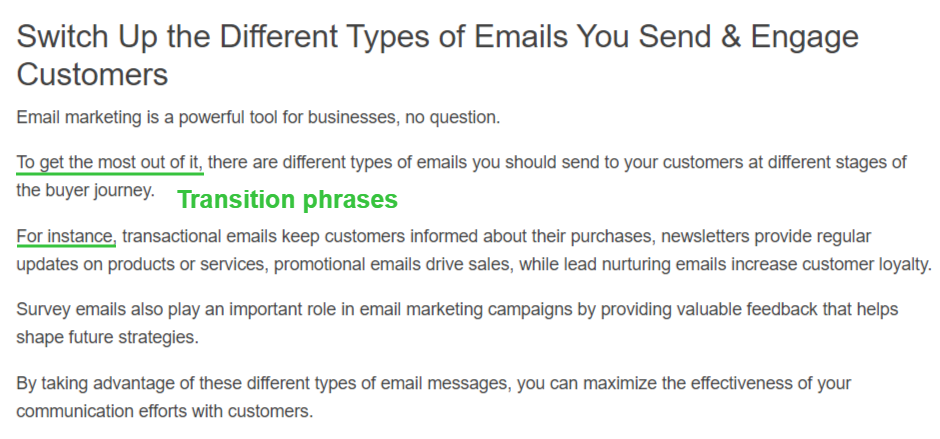
Conclusion paragraph with transitions.
Bottom line: Instead of throwing sentences at your readers like fastballs, consider gently leading them from idea to idea with transitions.
Add More “You” Language for a Personalized Touch
Using “you” language (aka second-person perspective) in your conclusion helps create a more personal connection with readers, making them feel like the content is speaking directly to them. This can be especially effective when paired with actionable advice or suggestions for next steps.
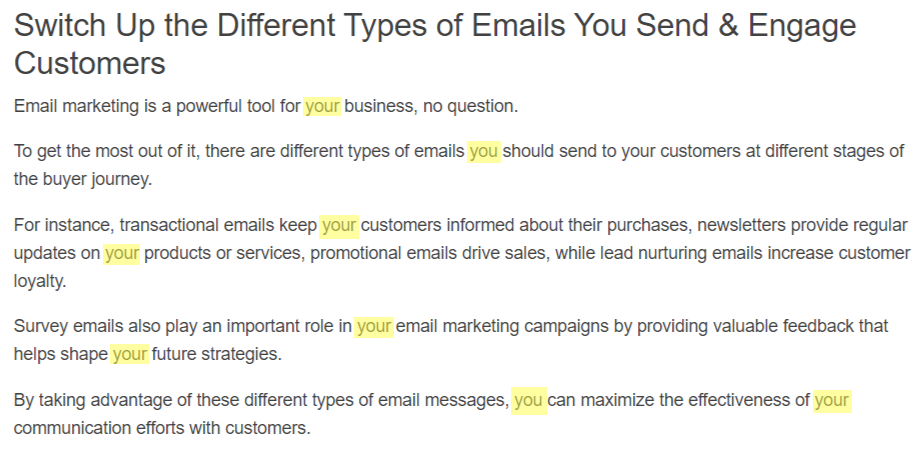
Next, to make content even more approachable for readers, it’s important to identify overly formal phrases in your writing and replace them with simpler alternatives.
How to Make Content More Approachable
How approachable is your content?
In other words, does it hold your reader at a distance with overly complex and formal language (something that plagues AI-generated content)? Or does it embrace them with easy-to-read sentences and simple phrasing?
Even if your brand audience is extremely intellectual and understands complex terms, you can still write in an approachable style that won’t put them to sleep. After all, approachable = engaging.
By simplifying complex phrases and embracing an easy-to-read style, you can ensure that your content resonates with potential customers while still conveying valuable information.
Identify + Cut Overly Formal Words & Phrases
The first step towards making your content more approachable is identifying any instances of overly formal language or jargon. These terms can make you sound unnecessarily stuffy. Not to mention, they may confuse or alienate readers who aren’t familiar with your specific industry terminology.
To help you spot these problematic phrases, consider using tools like the Hemingway App or Yoast SEO plugin for WordPress, which can analyze your text’s readability and highlight areas for improvement.
- Look out for long sentences: Sentences containing multiple clauses or ideas can be difficult to follow. Break them down into shorter, more digestible segments.
- Avoid passive voice: Active voice makes it clear who is performing the action in a sentence, creating a stronger connection between the subject and verb.
- Cut unnecessary words: Remove filler words such as “very,” “really,” or “quite” that don’t add value to your message.
Replace Complex Terms with Simpler Alternatives
To make your content more accessible without losing its effectiveness, try replacing complex terms with simpler alternatives.
- Use everyday language: Choose words and phrases that are commonly used in everyday conversation rather than technical jargon or industry-specific terms.
- Provide clear explanations: If you must use complex terminology, provide a brief explanation or definition to help readers understand its meaning and relevance to the topic.
- Incorporate examples: Use real-world examples or analogies to illustrate complex concepts, making them more relatable and easier for readers to grasp.
Here’s an example of an overly complex sentence in a conclusion:
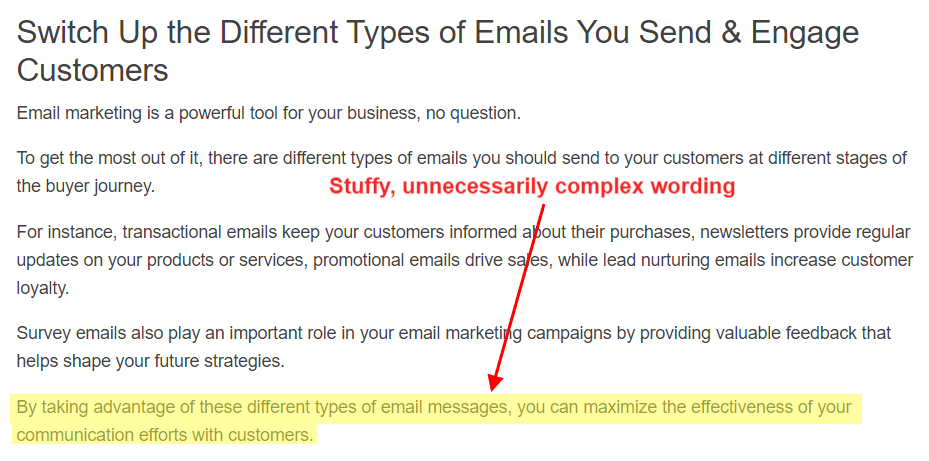
And here’s how I simplified the wording.
Before:
“By taking advantage of these different types of email messages, you can maximize the effectiveness of your communication efforts with customers.”
After:
“By taking advantage of these different types of
email messagesemails in your strategy, you can maximizethe effectiveness of your communication efforts withhow you talk to customers.”
Making content more approachable not only helps improve readability but also increases user engagement and trust in your brand. By following these tips, you can create content that appeals to a broader audience while still delivering valuable information effectively.
Remember, it’s important to prioritize clarity over complexity when crafting your content.
Crafting Effective Calls-to-Action (CTAs)
Creating compelling CTAs is crucial for driving engagement and conversions from prospective customers.
By grabbing readers with direct questions and showcasing the benefits of your offer, you can significantly boost conversion rates on your content marketing blogs. In this section, we’ll explore some strategies to craft effective calls to action that build trust with your audience.
Ask Direct Questions Before Presenting a CTA
One way to make your CTAs more impactful is by asking direct questions before presenting them. This creates urgency by prompting readers to consider their needs in relation to the offer. For example:
“Are you struggling to increase your website traffic? Our service can help. Click here to learn more.”
In this example, the question addresses a common pain point many businesses experience while also introducing the solution the company offers.
Highlight the Benefits of Your Offer
To further improve the effectiveness of your CTAs, showcase how users will benefit from choosing your offers. Here are some tips:
- Showcase tangible results: Use specific numbers or percentages whenever possible – e.g., “Increase website traffic by 50%.”
- Foster trustworthiness: Include testimonials or case studies as evidence of success – e.g., “See how we helped Company X grow their revenue by 200%.”
- Create a sense of urgency: Encourage users to act quickly – e.g., “Limited time offer: Get 30% off your first month if you sign up today.”
Remember, the ultimate goal is to make readers feel taken care of and confident when they choose to act on your CTA.
Use Actionable Language for Better Engagement
Actionable language helps motivate readers to take action after reading your blog post. Here are some tips for using actionable language effectively in your CTAs:
- Use strong verbs: Choose powerful action words like “discover,” “boost,” or “transform” instead of generic phrases like “click here” or “learn more.”
- Add personalization: Use personalized pronouns such as “you” and “your” to establish a connection with the reader – e.g., “Download Your Free eBook Now.”
- Avoid passive voice: Write in an active voice so your sentences sound more direct and compelling – e.g., change “Our guide can be downloaded here” to “Download Our Comprehensive Guide Today.”
Ultimately, the little details in your content contribute to whether or not a reader converts. Pay attention to them, because together they’ll add up to exceptional, engaging, conversion-worthy content.
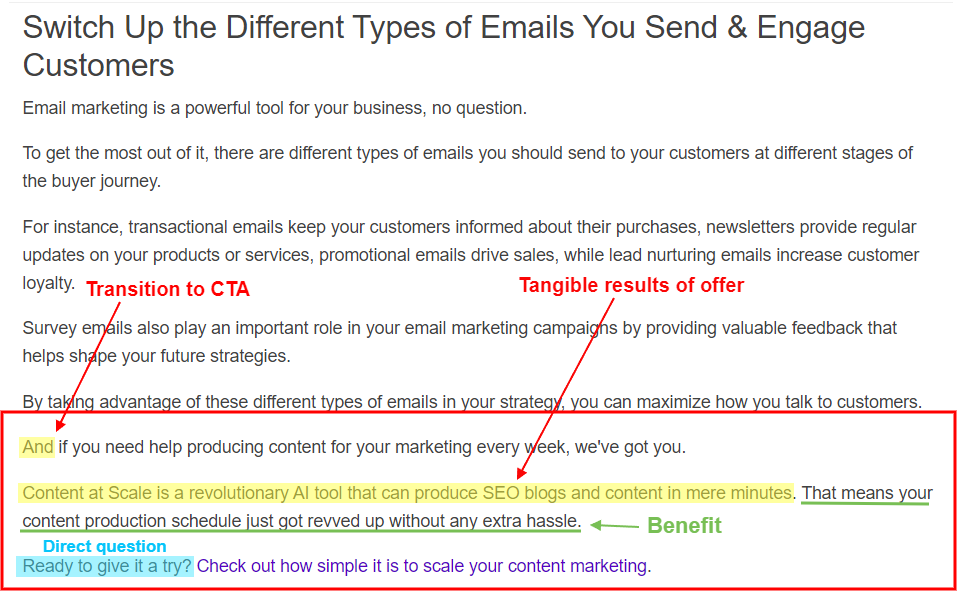
The final edited conclusion with Trust-building applied.
FAQs – How to Build Trust with Readers
How do you build trust in writing?
You build trust in writing by being consistent, clear, and honest. You also gain a reader’s trust by demonstrating your knowledge and expertise with accurate information that can be verified and by showcasing the value of your work through meaningful examples and thoughtful analysis.
Engage your audience through meaningful dialogue, communicating in a way that resonates emotionally and authentically.
How do you build trust in a conversation?
Writing is a conversation, so the same rules that work for building trust in spoken dialogue apply to writing. Showing the reader that you respect them by not talking over them, empathizing with them, and showing a deep awareness of their struggles will help you earn their trust.
How do you build rapport with readers?
The best way to build rapport – or establish a close bond – with readers is by being more human, which is particularly key with machine-generated content. You also build rapport by being truly helpful – generously sharing information that helps readers solve their problems.
Publish Impeccable AI Content At a Manageable Cost
You are not going to generate leads for your business or sign up more subscribers by churning out bland, soulless AI content that is published without human oversight. You may save money but you will not gain the readers’ trust, nor win their hearts.
Make your AI articles sound less like writing and more like conversations by using the tips we have shared in this article. That’s how you build readers’ trust in your ideas, teachings, and solutions.

UNLOCK YOUR POTENTIAL
Long Headline that highlights Value Proposition of Lead Magnet
Grab a front row seat to our video masterclasses, interviews, case studies, tutorials, and guides.

